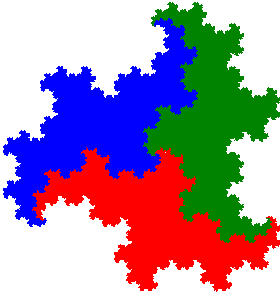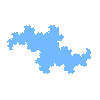


Construction
Animation
Begin with a line segment. As the first iteration, replace this segment with three segments in a Z shape, each scaled by a ratio \({\bf{r}} = \frac{1}{{\sqrt 3 }}\). The middle segment makes an angle of 60° with the first and last segments. Following along the original segment, we start the first new segment to the left. For the second iteration, replace each of the three segments with three new segments in the same motif, each scaled by the ratio r. The new segment groups are each placed starting to the left relative to the segment they replace. Continue this construction, always adding the new segment groups starting to the left along the segments of the previous iteration. This generates the "terdragon curve". The following figure shows the first three iterations for this construction.
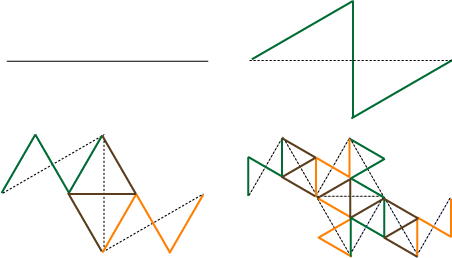
Fold a long narrow sheet in thirds, folding the first third towards you and the last third away from you. Fold three times again in the same directions (Example). Continue folding, always folding in the same directions. After several folds, open the sheet so that every fold is at 60° and view the sheet from the edge. In general, n sets of folds produce an order-n dragon. The following picture shows an order-2 dragon.
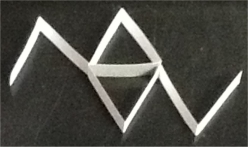
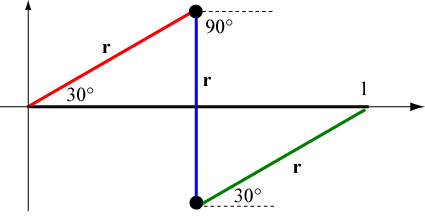
We see that
\[r = \frac{{1/2}}{{\cos {{30}^ \circ }}} = \frac{{\frac{1}{2}}}{{\frac{{\sqrt 3 }}{2}}} = \frac{1}{{\sqrt 3 }}\]
IFS
Animation
|
\({f_1}({\bf{x}}) = \left[ {\begin{array}{*{20}{c}}
{1/2} & { - \sqrt 3 / 6} \\
{\sqrt 3 / 6} & {1/2} \\
\end{array}} \right]{\bf{x}}\) |
scale by \(1/ \sqrt 3\), rotate by 30° |
|
\({f_2}({\bf{x}}) = \left[ {\begin{array}{*{20}{c}}
{ 0} & { \sqrt 3 /3} \\
{-\sqrt 3 /3} & { 0} \\
\end{array}} \right]{\bf{x}} + \left[ {\begin{array}{*{20}{c}}
1/2 \\
\sqrt 3 / 6 \\
\end{array}} \right]\) |
scale by \(1/ \sqrt 3\), rotate by −90° |
|
\({f_1}({\bf{x}}) = \left[ {\begin{array}{*{20}{c}}
{1/2} & { - \sqrt 3 / 6} \\
{\sqrt 3 / 6} & {1/2} \\
\end{array}} \right]{\bf{x}}+ \left[ {\begin{array}{*{20}{c}}
1/2 \\
-\sqrt 3 / 6 \\
\end{array}} \right]\) |
scale by \(1/ \sqrt 3\), rotate by 30° |
The terdragon consists of three self-similar pieces corresponding to the three functions in the IFS.
This L-system keeps the curve so that the starting and ending points are on a horizontal line as in the construction via line segments shown above.
6 iterations
An alternative L-system in which the orientation of the terdragon curve rotates as the iterations increase is given by the following.
Angle 120
Axiom F
F —> F−F+F
\[\sum\limits_{k = 1}^3 {{r^d}} = 1 \quad \Rightarrow \quad d = \frac{{\log (1/3)}}{{\log (1/\sqrt 3 )}} = 2\]
Three copies of the terdragon tile the plane. In addition to the regular terdragon, one copy must be rotated by 60° and the other by −60°. Click on each of the buttons in succession to see this tiling in the square below.

Six copies of the terdragon can be joined together at a common point at 60° angles.
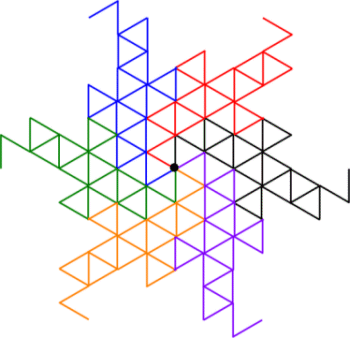

The image below shows six copies of the 6th iterate of the terdragon curve. Click on the play button to see an animation of the iterates starting at the beginning of each curve that demonstrates how each of the six different terdragons fit together. The three buttons labeled slower, normal, and faster will adjust the drawing speed.
The boundary of the terdragon is a fractal with dimension log(4)/log(3) = 1.26186 [Details].
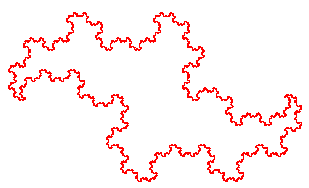
The area of a terdragon with an initial segment of length b is equal to \(\dfrac{b^2}{2 \sqrt 3}\) [Details].
Three copies of the terdragon form a fudgeflake. The fudgeflake can also be formed by placing copies of the lower boundary of the terdragon around the three sides of an equilateral triangle (similar to the construction of the Koch snowflake). Copies of the fudgeflake will tile the plane (if you look at the tiling picture above, you can see the red/blue/green grouping of three terdragons that make up one fudgeflake). Click on the name for more details.
